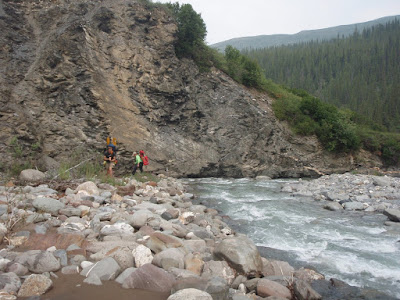Day 7 started fairly smoky. Tom and Marsh only noticed after packing up camp that they had a wardrobe malfunction.

Yes, they both had brought their bright green equinox marathon shirts, and didn’t appear to notice that they both put them on that morning until after camp was mostly packed. Life is tough sometimes – they spent the next two days in matching attire.

The hike out of the Tinayguk and into the hills around Wild Lake was the only bit of the trip though hard core swamp. The swampy section was brief but unpleasant.


The swampy section quickly gave way to wonderful ridge hiking and stayed that way for the rest of the trip.

During our lunch break Tom and I compared the quality and quantity of leg scratches – Tom won I think.

The hiking was truly spectacular as we followed a ridge surrounded by a series of high alpine lakes. As the day progressed the smoke blew away and it cleared up, giving us wonderful views of the surrounding peaks.

Eventually we reached our high point for the day and got our first sight of our final destination, Wild Lake.

In the evening we camped on a alpine lake, complete with a flock of loons and a two large families of necrotic ducks. The ducks spent much of the night acting like marines training for a amphibious assault – randomly panicking and zooming across the lake, sporadic diving under water with loud quacking, and swimming up and down the one side of the lake in a strait line. Perhaps the mother ducks where drilling into the ducklings the proper predator avoidance strategies. It was quite interesting to watch – one second they would be quietly bobbing on the lake, all by them selves, the “quack, quack, quack” the mad panic drill would be begin. At first I though they were afraid of the loons, but soon it became apparent that they did this even when the loons where on the other side of the lake. The camp site was very beautiful, and I went to sleep with the sound of the loons calling to each other. And of course panicked quacking.

Tom and Marsh where not content to simply hang out, and inflated their boats for some flat water paddling. They did discover a large school of pike though, again making me wish I had brought a fishing pole.

The lake also had some very small fresh water crabs. When I first saw them I mistook them for spiders, but on closer examination they where actually crabs of some sort. The lake had a surprising amount of wild life for a apparently landlocked lake about a quarter of a mile across.

Day 8 began with a short but intense ridge climb, then a several hour trek along a very smoky ridge top. The visibility was quite poor and at its worst was less than a quarter of a mile.
When we finally dropped down into Wild Lake the wind changed direction and the smoke blew away. Alas, our final destination was on the other side of the lake, so the wind also made the lake difficult to cross, so we walked up the lake in order to get a good position to hopefully blow across. Marsh decided the paddle while Tom and I hiked the shore. It was a refreshing chance of pace – completely flat hiking with almost no bush.

After a quick dinner the wind died down and we crossed the lake.

We spent the night at a friends cabin – thanks Trustin and Margette! It is on a edge of a 2006 vintage fire and went from a view of a dense spruce forest to a lake view with a nice patch of fire weed. The cabin was a great place to spend the last night on our trip.


The next day we where picked up by a Beaver from Brooks Range Aviation. The folks at BRA are truly super! They put us up for the night in one of their bunk houses, gave us hot showers, and even made us pizza! I cannot say enough nice things about these guys – if you are planning on a trip in the brooks range or Gates of the Arctic these are the folks to fly with.

After a hours flight we were soon over Bettles, back in civilization of a sort. Bettles is a pretty small town which appears to mainly serve as a hub into the back country. Its road accessible in the winter when the ice road is in, but in the summer the only way in and out is by boat or by plane.

After a night in Bettles we flew into Fairbanks via Warballows in a Cessna 2008 – quite a contrast with the flight into Bettles. The plane was at least 45 years newer and was packed with two archeologists from the National Park Service and a father son group who had floated one of the forks of the Koyokuk. After a hour or so we where back into town and back home!

This trip was truly fantastic and highly recommended!








































































